Access here Comprehensive Data on Electoral Bonds (as of February 2024)
The electoral bond sale data of the last 2 years has often been highlighted to conclude that the bonds are being purchased by the corporates and the rich. Data further indicates that 99.9% of the printed ₹ 1000 and ₹ 10,000 worth Electoral Bonds remain unsold.
The Government of India launched the Electoral Bond Scheme, on 02 January 2018. The then Union Finance Minister, Arun Jaitley has earlier made an initial announcement regarding the scheme during the 2017-18 annual budget presentation.

One of the reasons cited by the government for the introduction of Electoral bonds is to control the flow of unaccounted money into the political system.
However, there have been multiple apprehensions raised about the scheme. One of the key concerns is that it has made the process of political funding opaquer. Factly has earlier written on the issues relating to Electoral Bonds.
What did the Government say while introducing these bonds?
In a blog date 06 January 2018, the then finance minister Arun Jaitley expounded the reasons as to why Electoral Bonds are necessary. One of the aspects he highlighted was transparency. Since the whole transaction is being carried out through banking instruments, he stated that the amount flowing to the political parties is being accounted for.
However, the primary concern with the electoral bond scheme is the anonymity of the donors where in citizens have no way of knowing the identity of persons/organizations donating to political parties. Furthermore, there is inordinate delay in submission of mandatory reports to the Election Commission which results in complete absence of any information about the beneficiary political parties. Factly has earlier written a story, highlighting the delay in ascertaining the beneficiaries of the Electoral bonds.
Addressing the concern over this non-disclosure or anonymity, Arun Jaitley said that this was done to encourage more people to come forward to adopt more transparent means to donate to political parties, rather than cash donations.
He also said that electoral bonds serve as the best of compromise between protecting the interests of the donor as well as involving them in a more transparent form of political funding. While it is not known if Arun Jaitley was referring to small or large donors, his emphasis on donor anonymity comes out through these statements.
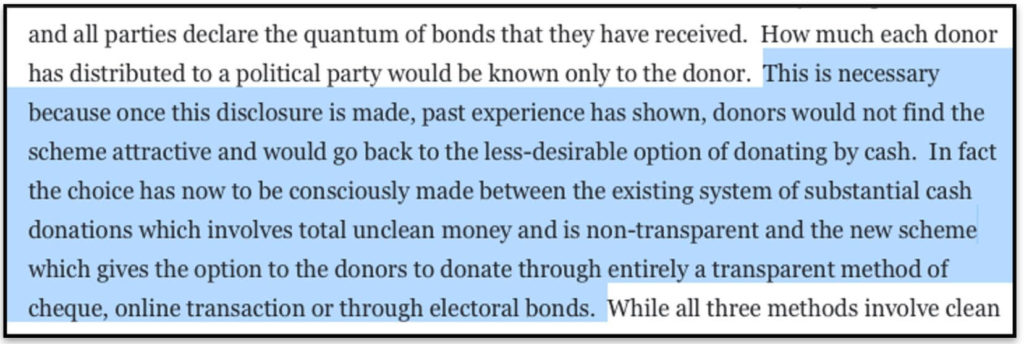
BJP requested for electoral bonds of lower denomination in addition to the higher denomination
An official letter sent by Bharatiya Janata Party on 17August 2017, to the then finance minister, Arun Jaitley lays stress on introducing electoral bonds of lower denominations and also protecting the identities of donors, to encourage more people to participate in the process of electoral funding. This letter was obtained by Commodore Lokesh Batra (retd) using Right to Information (RTI).

Electoral bonds led to an increased share of Political Party Income from undisclosed sources
As per ‘Analysis of Sources of Funding of National Parties: FY 2017-18’ report of the Association of Democratic Reforms (ADR), 53% of the income of the National Political Parties (excluding CPI(M)) is through undisclosed sources. This amounts up to ₹ 689.44 crores, of which ₹ 215 crores (i.e. 31% of undisclosed sources) is via the newly introduced electoral bonds.
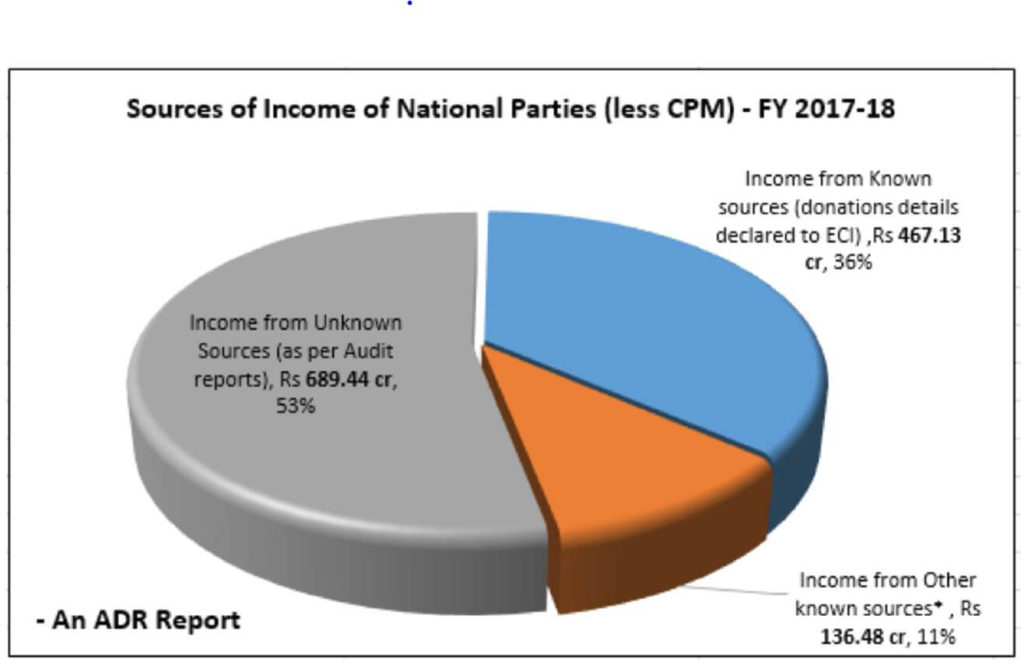
However, Analysis of Sources of Funding of National Parties: FY 2018-19 indicates that the share of income from undisclosed sources, in the case of national parties has increased to around 67% of the total income i.e. a total of ₹ 2,512 crores. Of these, ₹1960.68 (78% of undisclosed sources) is through Electoral Bonds.

The increase in the share and volume of income through undisclosed sources for major political parties can be attributed to the increase in the income through electoral bonds.
Since the value of Electoral Bonds purchased in April’19 & May’19 is higher than any other phase, the income of national political parties in 2019-20 may indicate an exponential increase. The share of their income through Electoral bonds and thereby share of income through undisclosed sources is also bound to increase in 2019-20. These numbers would be known only when the political parties submit their annual audit reports by October 2020.
However, this increase in the income of political parties through electoral bonds does not indicate that a greater number of people are willing to donate to political parties, as anticipated by Arun Jaitley. The data available so far indicates that there is hardly any demand for electoral bonds of lower denomination.
Less than 1% of all Electoral Bonds purchased so far are of lower denomination ( ₹1000 & ₹10,000)
Electoral Bonds are available in 5 different denominations, to accommodate political donations of varying magnitude. These denominations (all in ₹ ) are – One Thousand, Ten Thousand, One Lakh, Ten Lakhs & One Crore.
Since the inception of the scheme, electoral bonds were sold in 13 phases. A total of 12,452 electoral bonds have been sold so far in all these phases. Of these, the highest number of electoral bonds purchased were of ₹ 1 Crore denomination (5,702 bonds). The next highest number of bonds purchased were of the next higher denomination i.e. ₹ 10 lakhs (4,911 bonds).
1,722 electoral bonds of ₹1 lakh denomination were purchased during these 13 phases. As per ECI norms, all political parties are required to furnish the details of donations received in excess of ₹ 20,000. However, this norm is not applicable if the donation is made through an electoral bond.
The only two denominations of electoral bonds whose value is less than this anonymous ₹ 20,000 limit are ₹ 1000 and ₹ 10,000. Only 47 and 70 bonds of these denominations are purchased respectively.
These numbers clearly indicate that, the electoral bonds have facilitated a substantial increase in high value anonymous donations. The electoral bonds do not seem to have encouraged any increase in smaller donations contrary to the arguments made by the then finance minister.
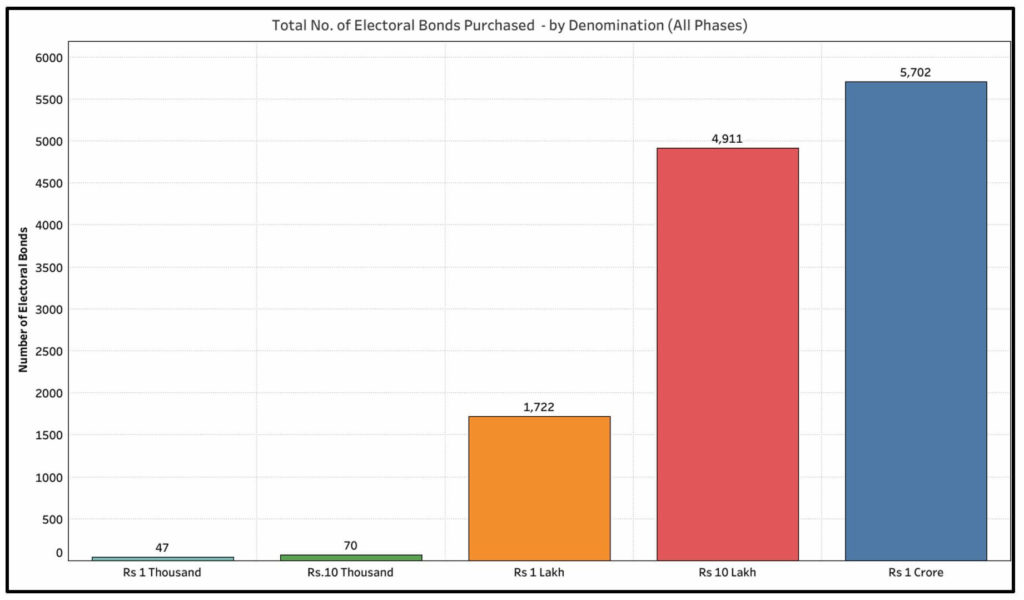
In terms of value, a total of ₹ 6,210.39 crores worth of electoral bonds were purchased so far out of which ₹ 1 Crore denomination bonds amount to ₹ 5,702 crores i.e. 91.81 % of the total worth of bonds purchased so far.
Large number of lower denomination Electoral Bonds remain unsold
The low sales of ₹ 1000 and ₹ 10,000 denomination bonds are not only contrary to the initial perception created by the government that there would be lot of takers for these denominations, they have also meant financial implication for the government.
The Electoral Bonds are physical copies which are sold by SBI. Information obtained by Commodore Lokesh Batra (retd) using RTI reveals that the printing of these bonds is being carried out at India Security Press Nashik.
The RTI information provided by SBI indicates that the printing of these bonds was carried out both in 2018 and 2019. The volume of Electoral Bonds printed is given in the following table.
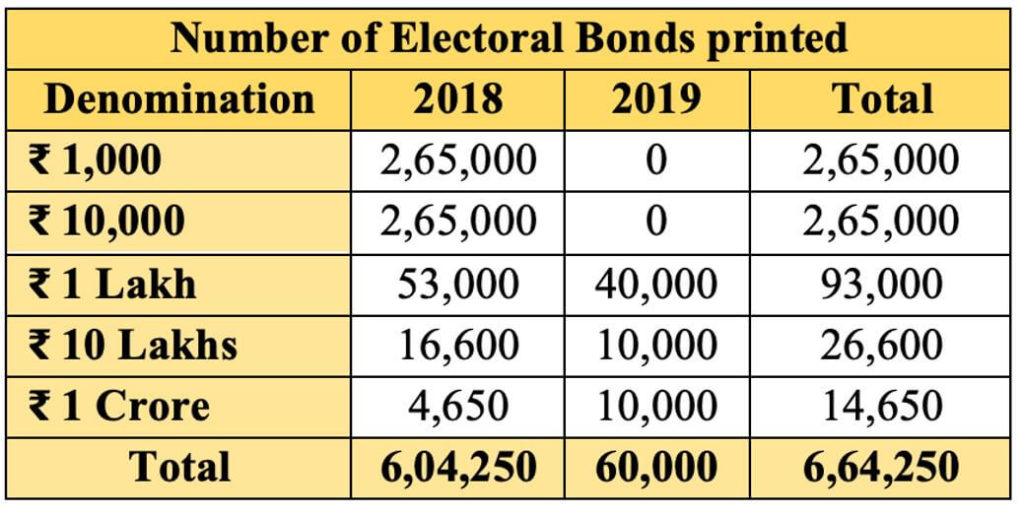
As the data indicates, a large number of electoral bonds of ₹ 1000 and ₹ 10,000 denomination were printed by the government initially in 2018. A total of 2.65 lakh electoral bonds were printed in of these two denominations. This is exponentially higher than the number of bonds printed for the higher value denomination. In 2019, however, the government stopped printing the lower denomination ones as they remained unsold.
As seen earlier, the actual sale of the electoral bonds of lower denomination is negligible. Only 47 and 70 bonds of ₹ 1000 and ₹ 10,000 denomination respectively as against 2.65 lakhs each printed in 2018, which means 99.9% of these printed lower denomination bonds remain unsold.
The one lakh denomination also does not fare better either with 98.14 % of the printed bonds remain unsold. Looking at the trend in the 13 phases, it is highly unlikely that the already printed lower denomination bonds would be sold any time soon.
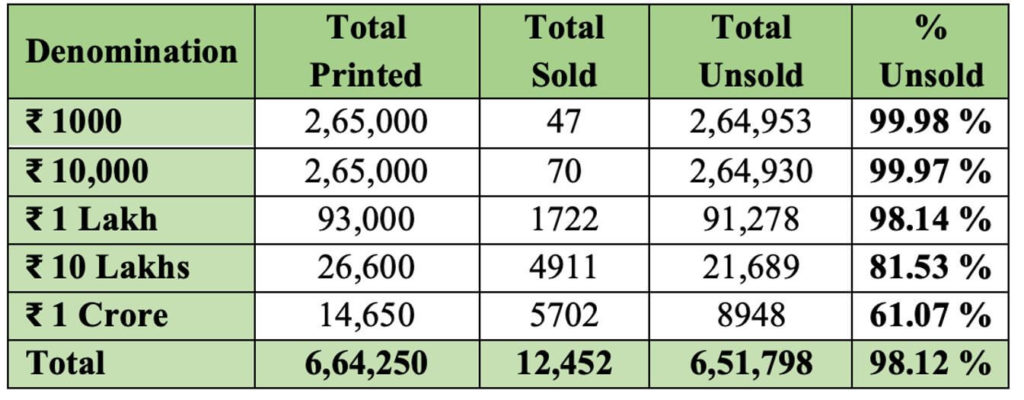
As per an invoice submitted by Indian Security Press, Nashik for printing these bonds, the unit price for printing each electoral bond is ₹ 25 (excluding GST). A further 12% GST (6% CGST + 6% SGST) was charged in the invoice.
Based on these numbers, the total cost of printing 6,64,250 Electoral Bonds comes up to around 1.66 crores without GST. 12% GST adds up to another 19.9 lakhs i.e. approximately ₹1.85 crores is the total cost incurred by the government to print the Electoral Bonds.
With more than 5.2 lakh electoral bonds of ₹ 1000 and ₹ 10,000 denomination remaining unsold, it does appear like an unnecessary burden of more than a crore rupees on the public exchequer.
High volume of unsold electoral bonds shows improper planning
Transparency in political funding process and encouraging larger participation in the process of political funding were mentioned as some of the prime reasons for introducing electoral bonds. However, the increase in the share and volume of income through undisclosed sources negates the transparency argument.
The donor anonymity in the electoral bond scheme was justified as a means to encourage large scale small donations to political parties. However, the numbers in the last two years and the 13 phases clearly indicate that the bonds are being purchased by corporates and larger players, rather than individuals and small donors.
Furthermore, the printing of 2.65 lakh electoral bonds each of ₹ 1000 and ₹ 10,000 denomination indicates complete lack of planning & understanding on the government’s side. The government’s initial estimate has gone horribly wrong as 99.9% of these bonds remain unsold and it does not look like they will be sold any time soon. Not only the stated goals for the introduction of these bonds stand negated but also have resulted in an unnecessary financial burden on the public exchequer.


